While playing my previous game, I came across this CivFanatics thread, proposing that wide ICS-like gameplay might be the fastest route to a culture victory, using the culture bonus of France. This, naturally, intrigued me very much, so I embarked on such a game myself.
I'm going to keep this report to one page as a high level overview, rather than going into the deep details. There isn't much new in the mechanics here. The game parameters are as set out in the CFC thread: Emperor difficulty, Pangaea map, France, normal speed.
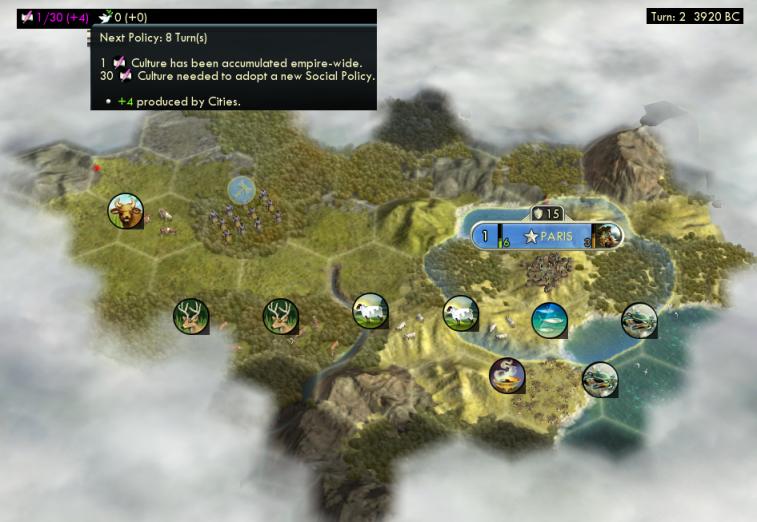
Here's my start after settling, and after a ruin pop on turn 2 gave me culture for an impossibly fast Liberty opening. I went on to rack up a great haul from ruins: Mining, Calendar, two population growths, culture again (Republic policy on turn 9), 75 and 90 gold.
I opened scout - scout - granary and bought a worker. The settler policy came on turn 20, for a second city on turn 22.
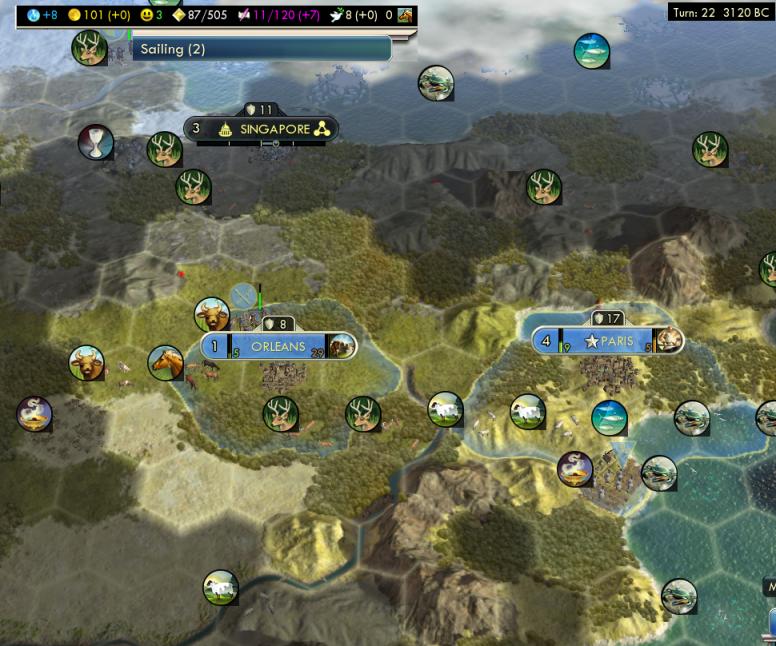
I'll skip the details of selling resources, buying workers and work boats, and micromanaging growth and happiness. Just suffice it to say that the snowball accelerated rapidly.
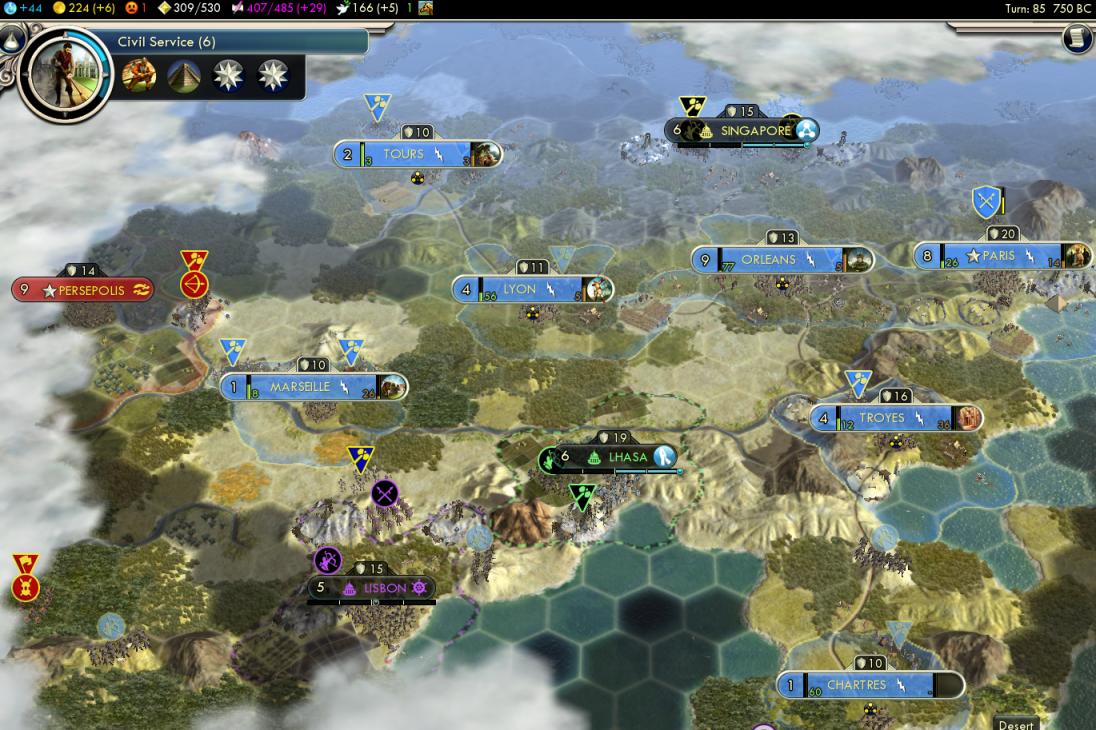
Here's an overview at 750 BC, with seven cities. Lyon and Tours had one new luxury each and Chartres had two, making six types total. Every city except Lyon was quite strong, with four or five resources and some good land. Troyes is starting Petra with several desert hills there. Marseille had no new luxes, but amazing growth potential with three floodplains wheat. I got that location by blocking a Persian settler for several turns with a scout and archer.
The picture is right before finishing Liberty on this schedule:
I had determined the direction to take this game now. I would try out Rationalism for a culture game, using it to hurry on up to Cristo Redentor and Sydney Opera House, hoping that reaching them quickly would make up for skipping the culture stuff in Piety. This map is perfect for building around SOH, with a very strong capital on the coast, something you don't usually get. As for cities, I was trying to take a smart-wide approach. I'd build lots of cities as long as they were all good, with decent land and five or so resources. But I wouldn't try to ICS into every dismal tundra alcove.

Religion went as follows. I was first to a pantheon, on turn 41, and took Messenger of the Gods to stick with the thrust of wide research. Turn 95 founded the religion, taking obviously Cathedrals, and I guess Tithe for the founder belief. By the time of enhancement, I was seriously hurting for happy so Religious Center was the best option. Religious Texts for enhancer got swiped ahead of me, so I settled for Itinerant Preachers as the next best option. (They are of very comparable strength: Itinerant Preachers expands each city's pressure reach from 330 tiles to 216 additional, a gain of 65%. But Religious Texts is better because it snowballs faster; it's better to apply stronger pressure to convert a city sooner for it to begin applying its own pressure.)
The religion developed very slowly. Passive spread from the one holy city is useless; I had to buy two missionaries for 5 cities' worth of spread to bootstrap it. Once that happened, it did gradually spread on its own and eventually encompassed the entire western half of the pangaea. Religion developed slowly also because I was rocketing through eras quickly and increasing the faith costs. I didn't get to buy my first cathedral until around turn 160, and only got them to about half the cities before the game ended.
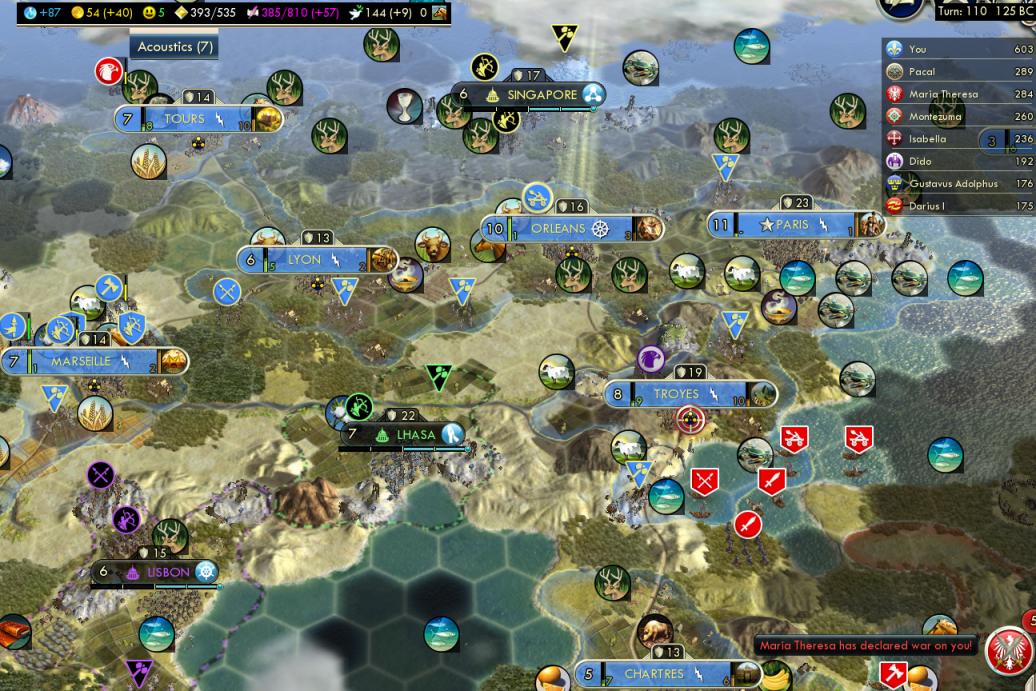
Thanks to happy constraints, I could only add an 8th city before 1 AD (Avignon top-right underneath the scoreboard.) Austria to my southeast distracted me with a war, but I held that off easily thanks to the comp-bows I'd had ready over by Persia (knowing that Marseilles would piss him off something firece). Austria would declare on me two other times throughout the game, all fought to stalemates at Chartres.
I felt that my infrastructure was really lagging for the sake of expansion. I had no libraries yet, and had even skipped monuments in many cities for the sake of more workers and settlers and happy buildings (circuses) and expansive wonders like the Pyramids. But for a wide game, that might indeed be the right thing to do. (As they say in Civ 4, don't build the Great Library, build the "3 Settlers And Workers" wonder instead.)
Happiness was very constraining. I think I erred in taking Messenger of the Gods and Tithe instead of happy beliefs. Cathedrals are not a happy solution, they take way too long. I was having to build way too many circuses and colosseums and temples (with Religious Center) instead of snowball-advancing stuff. I wanted to go conquer Persia, but could never muster the 10+ surplus happiness it would take to puppet Persepolis.
So it was domestic building instead of conquering. Early wonders included the Pyramids, Terracotta Army, and the Oracle. (I wasn't playing any crazy tricks like trying to save Oracle for a Renaissance policy.) Looking ahead, I would get the Oracle plus one other policy before reaching the Renaissance for Rationalism. I considered Patronage, but ultimately went with the Tradition opener and Aristocracy. There were a lot more medieval wonders to build: Machu Picchu, Alhambra, Great Mosque, Chichen Itza, Sistine Chapel.
I reached the Renaissance by Acoustics as usual. In 50 AD, which is seriously fast; more like 500 AD is more typical for a thinner culture game. To get to the Industrial Era, I considered several paths, but ultimately wound up following good old Fertilizer. Those tile boosts at Chemistry and Fertilizer are just so good, thanks to just immediately passively working, not like sinking 360 hammers into a hospital or factory. And the path goes through reassuring defensive stuff, muskets and cannons.
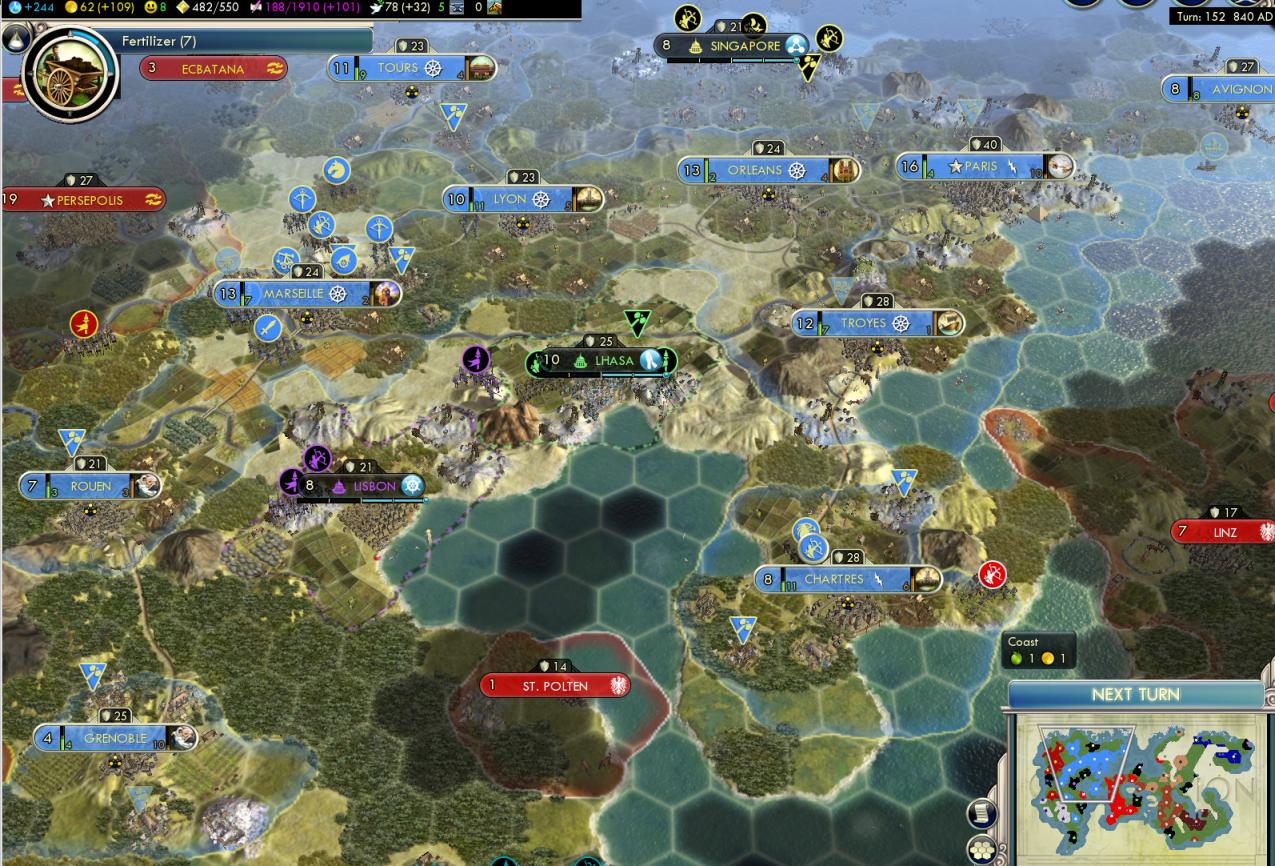
Here's an overview. I'd expanded out to 11 native cities (one offscreen south of Grenoble) and would stop there. This wasn't exactly super wide, but not dedicated tall either, approaching size 20 but not 30. Coin this approach as "square", perhaps, with a number of cities built to similar height, so the population distribution is shaped neither wide like or tall like but "square" like .
Anyway, here I took a moment to compare this square-wide culture game to my orthodox tall Boudicca culture game at the same date. That wasn't a particularly fast or optimized culture run, but it made a good baseline comparison.
| Turn 152 | Boudicca | Napoleon |
| Beakers | 87 | 244 |
| Gold | 49 | 109 |
| Culture | 49 | 101 |
| Policies | 9.5 | 11.1 |
| Population | 44 | 104 |
| Researching | Acoustics | Fertilizer |
| Crop Yield | 119 | 305 |
| MFG | 61 | 182 |
Holy crap, wide works well! Over double in all the productive categories, nearly triple in the key measures of food and hammers. An entire era ahead in technology. And culture is indeed a better rate, producing double with Napoleon but I'm paying costs less than double of Boudicca, it's 200% of base with eleven cities as compared to 130% of base with four. Wow, this plan might work indeed. Can we keep this up, staying ahead of pace as the inflated policy costs start to escalate?
Presently I started a serious push to Opera Houses to get that Hermitage up. Although it came fifty turns after actually researching Acoustics, the timing then worked out well. Most cities built their Opera Houses, except four newer cities where I had to buy them after building just amphitheaters. That worked out well, neatly consuming the 3k gold I'd accumulated. And it was timed right along with the Freedom specialist food and then anger reductions.
Policies 12 to 18 went into Freedom as follows:
The two big midgame happy wonders are under construction in the previous shot, Notre Dame in Orleans and Forbidden Palace in Tours. I sat on that for a few turns in order to finally fulfill the happiness Golden Age, then at long last moved in to conquer Persia.
I conquered Persia down to one city, then took peace rather than crawl through the jungle to one last city. I puppeted the cities, lacking the happiness to annex them, and also feeling that they wouldn't be able to contribute enough culture to cover the added costs. These cities proved virtually useless as puppets for culture, though. I see reports of culture games acquiring over 200 culture/turn worth of puppets... how do you get the puppet AI to build any culture stuff? My Persian cities dumbly built everything in the bank line of buildings, then military junk like barracks and castles... a hundred turns later they might have built a monument or two but I was ignoring them by then.
Anyway, Carthage was south beyond Grenoble. I had intended to continue conquering there, but once again the happy cap prevented me, and also Dido went and became my best friend so I didn't want to hurt her. We had denounced Austria together, who everybody hated, and that parleyed into two more friendship agreements for me. Of course friendship agreements mean research agreements, and I got research going very nicely with them. I had I think 9 RAs throughout the game.
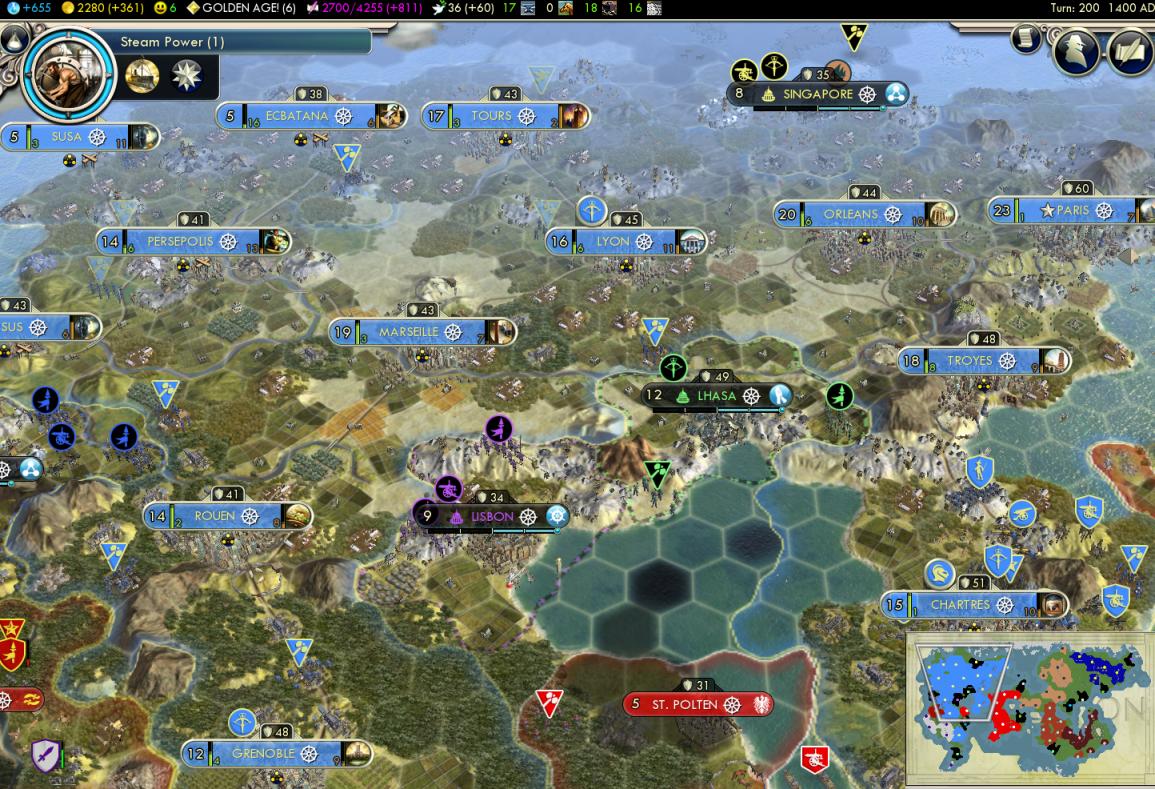
At turn 200, here's the vital stats. 655 beakers, researching Steam Power. +360 income in Golden Age. Over 800 culture, and burning through policies wicked fast in 6 turns each. That's the Taj Mahal Golden Age, which produced tons of cash to buy up every city-state on the map. (I already had half of them thanks to the usual assorted quests, including one Great Prophet to go satisfy four spread-religion requests.)
Research after Fertilizer was to Scientific Theory (LOTS of lumbermills), then to Archaeology. I know you're supposed to buy the culture buildings right away, but with so many of them, it felt I had to let the stronger cities build them and wait for Big Ben to buy them for the laggards. This proceeded over time, with my huge gold income that stayed over 200/turn and hit 400 in Golden Age. Largely thanks to Machu Picchu which is incredibly strong for a wide build, producing nearly 100 by itself.
I reached Radio quickly, and started buying Broadcast Towers over Museums where there was a choice. They each produce just about the same culture for the money; the museum is $780 for 11 culture and the Broadcast Tower is $1150/16c in cities with a cathedral. But the Tower is preferable because it doesn't require filling more specialist slots.
Popped Great Artists at 200, 400, 500, 600, 700 from cities, and bought two at the 1000 and 1500 faith levels. Then the Louvre artists hit and also the Porcelain Tower. One Louvre artist settled but the other went for a Golden Age, which I'd keep running from now through the end of the game. A Golden Age would be +20% of 790 = 158 cpt x 16 turns = 2528 culture. A Landmark would be 12 + 128% = 27 cpt, so needs nearly 100 turns to come out ahead of the GA. Around this time, I chanced to read some thread on CFC that claimed a culture game should keep Golden Ages going from Taj Mahal through the end of the game. That advice is very much correct and I will make sure to start Golden Ages earlier.
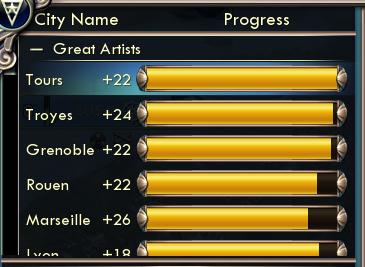
One detail that didn't go well was endgame Great Artist production. I ended up with that choking logjam of Great Artist points that couldn't cash out from all these cities, the counter constantly getting escalated just out of reach. Getting Opera Houses and Museums going sooner would have fixed this. Several of these Artists finally spawned over the last 50 turns of the game, but too late to clock off the Golden Ages before the end of history, so settled as rather subpar landmarks.
After the bulb from PT, I built Oxford University to claim Ecology on turn 224 1570 AD. That went extremely well, I reached the Sydney Opera House with seven policies still to go and got great use out of it. It gave 100 or more culture/turn for almost 50 turns, so that's worth another half-policy on top of its free one.

So SOH was great, but then, like, what do I do now? The whole empire is geared for research, over 1100 beakers/turn, but now there's nothing on the tech tree that matters for culture. The CN Tower might be mildly exciting, except that I'd already bought almost all the Broadcast Towers. Well, there was Railroad for Neuschwanstein for a bit of culture (for a lot of busywork on walls and castles) but that was about it.
There is nothing, nothing, nothing but military units as far as the eye can see on the tech tree from here. Dear gosh, this area of tech is phenomenally boring if you're not fighting. Why does the Civ 4 tech tree have you one-more-turning to the next unlock while the Civ 5 tech tree gets so dry? Where did all the interesting stuff go?
I know where it went. The social policy trees. Bingo, that crystallizes a feeling I'd had about Civ 5, that culture victories are so much more interesting than the other types and now I see why. Social policies hold all the interesting things that happen to an advancing empire. Picking your research in Civ 4, you're hotly anticipating that next government type, the next trade route or corporation, the next slingshot. Civ 5 moved most of that into the social policies, leaving the tech tree dull and boring. Military breakpoints are the one thing that still could be exciting, except that they hardly exist in Civ 5 since all the unit classes are now so smoothly gradiated. (There are a couple exceptions, notably Flight.) But anyway the AI's tactical prowess means you hardly even need superior units anyway. So the Civ 5 tech tree stays dull after the cool kids left to hang out over in the policy trees.

Similarly, the next policy (#21) had me kind of stuck too. The remainders of Tradition and Rationalism were unexciting now, with growth and science now moot. Patronage was unnecessary when I already had all CS allied and plenty of money and spies to remain so. Commerce has no culture. Honor has a small slice that hardly seems worthwhile with the busywork to garrison a unit in each city.

No, here's the answer: Finish Rationalism anyway, then take a sharp U-turn into Piety for the culture boost and discount there. They should save three or four turns, which nothing in any other policy tree can do now. Abandon Rationalism, we don't need the science. The happy loss from Humanism would be a minor concern but Neuschwanstein and Eiffel Tower would compensate.
BTW, that turn of "anarchy" affects only exactly what it says in science, gold, and production. Culture still gets produced!
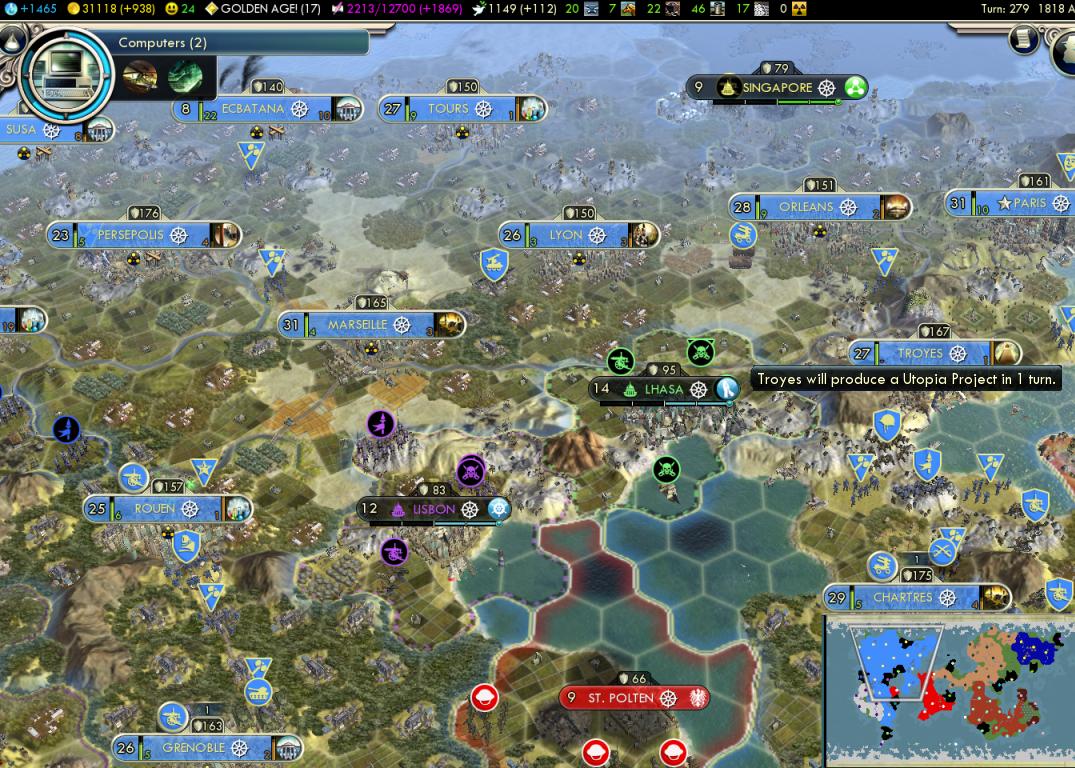
One final overview, and it's a Cultural Victory on turn 280 1820 AD.
So that worked out kind of well in the end, decently fast, sub 300 by 20 turns. But the plan of wide Rationalism then Piety isn't the way to set new culture speed records. Sydney Opera House isn't strong enough to sacrifice Piety to get there with Rationalism. And reaching Opera Houses and Museums faster does not help, before you've developed the gold or hammers or spare citizens to buy or build or staff them.
Also, France is a misguided choice. France gets policies quickly early, and does accelerate with more cities, but how fast that happens is irrelevant to the final culture time. Early policies can speed finish time only by accelerating the snowball, notably the Liberty stuff and Tradition finisher. But the numbers make the early policies just irrelevant in the end. How fast you get to 800 culture for the first 8 policies plays zero bearing on the finish date when that 800 is less than half a turn. To speed up culture means to speed up not policies one through ten, but policies 25 through 30 that cost 40,000 aggregate culture.
So how wide should you go for culture? I believe this post by BWS has it right. Basically any city that can build a world wonder for Reformation's +33% will pull its weight over the course of the game, breaking even on culture pace while adding gold and research and military and faith. So the fastest culture probably is a bit wider than the classic four cities, could be five or six. In fact, I think the correct wideness is whatever will produce exactly enough science to reach Sydney Opera House for the 30th policy.
I am definitely going to try a true speed culture game, so stay tuned.